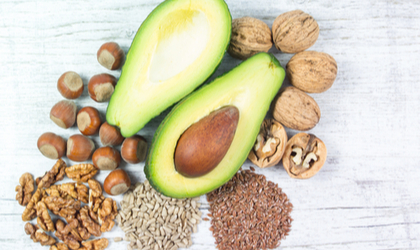
Not all fats are created equal. There’s the good kind: unsaturated fats. And the bad kind: saturated fats and trans fat. No matter what diet you subscribe to, healthy unsaturated fats should form a foundational basis. Indeed, the dietary fats found in oily fish, nuts, seeds, and vegetable oils are among the most nutrient-dense foods on the planet and support countless areas of health.
And yet, on a molecular level, unsaturated fats can be a little confusing. Most people are familiar with omega-3 fatty acids. But omega-6 fatty acids? These compounds certainly don’t have the same sunny reputation. This doesn’t make them any less important, however.
The real issue is striking a healthy balance between omega-3 fatty acids and omega-6 fatty acids. But according to researchers, achieving this ratio is becoming increasingly challenging in Western diets (1).
What are omega-3 fatty acids?
Omega-3 fatty acids are healthy polyunsaturated fats. Chemically speaking, polyunsaturated fats contain more than one unsaturated carbon bond in the molecule, otherwise known as a double-bond (2). It can be helpful to remember that ‘poly’ means ‘many’.
Given the human body can’t produce omega-3 fatty acids, these compounds are considered ‘essential fats’, which means you have to obtain them from your diet.
There are three different types of omega-3 fatty acids, which vary based on their chemical structure.
-
Eicosapentaenoic acid (EPA) – long-chain fatty acids
-
Docosahexaenoic acid (DHA) – long-chain fatty acids
-
Alpha-linolenic acid (ALA) – short-chain fatty acids
It’s worth mentioning that although short-chain ALA fatty acids can be converted into long-chain EPA and DHA fatty acids in the body, this isn’t a particularly efficient process.
What do omega-3 fatty acids do in the body?
Omega-3 fatty acids play an integral role in health, contributing to:
-
Normal vision*
-
Normal brain function*
-
The normal function of the heart**
-
The maintenance of normal blood pressure***
* A beneficial effect is obtained with a daily intake of 250mg of DHA
** A beneficial effect is obtained with a daily intake of 250mg of DHA and EPA
*** A beneficial effect is obtained with a daily intake of 3 grams per day of DHA and EPA
Omega-3 foods
You can find DHA and EPA in the following oily fish and seafood:
-
Salmon
-
Anchovies
-
Herring
-
Mackerel
-
Sardines
-
Trout
-
Oysters
-
Sea bass
-
Prawns
To maintain a healthy, balanced diet, The NHS recommends eating at least two portions of oily fish a week (3).
You can find ALA in the following plant foods:
-
Nuts – walnuts
-
Seeds – flaxseeds, hemp seeds, chia seeds
-
Vegetable oil – flaxseed oil, flaxseed oil, linseed oil, algae oil
-
Seaweed and microalgae
-
Leafy green vegetables – Brussels sprouts, kale, spinach, broccoli
-
Kidney beans
-
Edamame
Discover our top 10 plant-based sources of omega-3 here.
What are omega-6 fatty acids?
Like omega-3 fatty acids, omega-6 fatty acids are healthy polyunsaturated fats that can’t be found in the body. This means you must obtain omega-6 from dietary sources alone.
There are four different types of omega-6 fatty acids:
-
Linoleic acid (LA)
-
Arachidonic acid (ARA)
-
Gamma-linolenic (GLA)
-
Conjugated linoleic acid (CLA)
What do omega-6 fatty acids do?
Although omega-6 fatty acids don’t enjoy the same reputation as their cousins omega-3 fatty acids, they are nonetheless important. These compounds are found everywhere in the body and support cell function (4).
However, moderation is key. If we don’t eat enough omega-6 fatty acids, our cells won’t operate properly. But if we consume too much, our cells might react and harm the rest of the body.
Omega-6 foods
You can find omega-6 fatty acids in the following foods:
-
Vegetable oils – soybean oil, safflower and sunflower oils, corn oils
-
Seeds – sunflower seeds, pumpkin seeds
-
Nuts – walnuts
Omega-3 to omega-6 ratio: striking the right balance
Years ago, our ancestors consumed a healthy balance of omega-6 fatty acids in the ratio of 1:1. However, in the last few decades, our intake of omega-6 has increased exponentially, while our consumption of omega-3 has fallen. Some experts believe the omega-3 to omega-6 ratio today is around 1:17 (5).
One reason for this is the change in modern agriculture and the 20th-century trend to refine food. Western populations now consume vast amounts of processed vegetable and seed oil (soybean oil, corn oil, and sunflower oil) – many of which are crammed with omega-6 fatty acids.
The problem is that an unbalanced ratio in favour of omega-6 fatty acids isn’t good for our health, particularly when we know that several vital organs depend on omega-3 fatty acids (6).
In an ideal world, we should be aiming for an omega-3 to omega-6 ratio of 1:3 (7). The World Health Organisation (WHO) recommends a daily omega-6 intake of 2.5-9% of energy and a daily omega-3 intake of 0.5-2% of energy (8).
To achieve this, we must try to eat more omega-3 fatty acids from oily fish (at least two portions every week), nuts and seeds, and use extra virgin olive oil for cooking and salad dressing (9). Additionally, we should try to limit our consumption of other vegetables and foods that have been fried in refined vegetable oils (9).
Head back to our dedicated blog to learn more about supporting your health and wellbeing.
References
- Simopoulos, AP. (2006) Evolutionary aspects of diet, the omega-6/omega-3 ratio and genetic variation: nutritional implications for chronic diseases. Biomed Pharmacother. (9): 502-7.
- www.heart.org. 2021. Polyunsaturated Fat. [ONLINE] Available at: https://www.heart.org/en/healthy-living/healthy-eating/eat-smart/fats/polyunsaturated-fats
- nhs.uk. 2021. Fish and shellfish. [ONLINE] Available at: https://www.nhs.uk/live-well/eat-well/fish-and-shellfish-nutrition/
- OMEGA-6 FATTY ACIDS: Overview, Uses, Side Effects, Precautions, Interactions, Dosing and Reviews. [ONLINE] Webmd.com. Available at: https://www.webmd.com/vitamins/ai/ingredientmono-496/omega-6-fatty-acids
- Simopoulos, AP. (2006) Evolutionary aspects of diet, the omega-6/omega-3 ratio and genetic variation: nutritional implications for chronic diseases. Biomed Pharmacother. (9): 502-7.
- Russo GL. (2008) Dietary n-6 and n-3 polyunsaturated fatty acids: from biochemistry to clinical implications in cardiovascular prevention. Biochem Pharmacol. 77(6:937-46.
- Patterson, E., Wall, R., Fitzgerald, G. F., Ross, R. P., & Stanton, C. (2012). Health implications of high dietary omega-6 polyunsaturated Fatty acids. Journal of nutrition and metabolism, 2012, 539426.
- Nutri-facts.org. 2021. Essential Fatty Acids Intake Recommendations - NUTRI-FACTS. [ONLINE] Available at: https://www.nutri-facts.org/en_US/nutrients/essential-fatty-acids/essential-fatty-acids/intake-recommendations.html
- Finding the right omega 3 and 6 ratio is key to protecting cell membranes. [ONLINE] Available at: https://www.nutraingredients-asia.com/Article/2014/12/22/Finding-right-omega-3-and-6-ratio-is-key-to-protecting-cell-membranes
Related Posts
Disclaimer: The information presented by Nature's Best is for informational purposes only. It is based on scientific studies (human, animal, or in vitro), clinical experience, or traditional usage as cited in each article. The results reported may not necessarily occur in all individuals. Self-treatment is not recommended for life-threatening conditions that require medical treatment under a doctor's care. For many of the conditions discussed, treatment with prescription or over the counter medication is also available. Consult your doctor, practitioner, and/or pharmacist for any health problem and before using any supplements or before making any changes in prescribed medications.

Keri
Keri Filtness has worked in the Nutrition Industry for 19 years. She is regularly called upon for her professional comments on health and nutrition related news. Her opinions have been featured by BBC3, Prima, Vitality, The Mirror, Woman’s Own and Cycling Weekly, amongst others. She has also worked one to one with journalists, analysing their diets and health concerns and recommending changes and additions, where appropriate.



